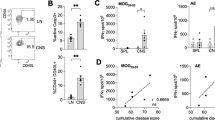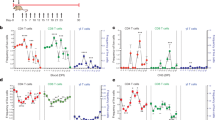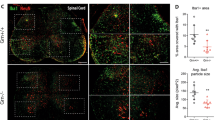Abstract
Little is known about the processing of putative human autoantigens and why tolerance is established to some T cell epitopes but not others. Here we show that a principal human HLA-DR2–restricted epitope—amino acids 85–99 of myelin basic protein, MBP(85–99)—contains a processing site for the cysteine protease asparagine endopeptidase (AEP). Presentation of this epitope by human antigen-presenting cells is inversely proportional to the amount of cellular AEP activity: inhibition of AEP in living cells greatly enhances presentation of the MBP(85–99) epitope, whereas overexpression of AEP diminishes presentation. These results indicate that central tolerance to this encephalitogenic MBP epitope may not be established because destructive processing limits its display in the thymus. Consistent with this hypothesis, AEP is expressed abundantly in thymic antigen-presenting cells.
This is a preview of subscription content, access via your institution
Access options
Subscribe to this journal
Receive 12 print issues and online access
$209.00 per year
only $17.42 per issue
Buy this article
- Purchase on Springer Link
- Instant access to full article PDF
Prices may be subject to local taxes which are calculated during checkout





Similar content being viewed by others
References
Martin, R., McFarland, H. F. & McFarlin, D. E. Immunological aspects of demyelinating diseases. Annu. Rev. Immunol. 10, 153–187 (1992).
Steinman, L. Multiple sclerosis: a coordinated immunological attack against myelin in the central nervous system. Cell 85, 299–302 (1996).
Anderton, S., Burkhart, C., Metzler, B. & Wraith, D. Mechanisms of central and peripheral T-cell tolerance: lessons from experimental models of multiple sclerosis. Immunol. Rev. 169, 123–137 (1999).
Ota, K. et al. T-cell recognition of an immunodominant myelin basic protein epitope in multiple sclerosis. Nature 346, 183–187 (1990).
Martin, R. et al. Fine specificity and HLA restriction of myelin basic protein-specific cytotoxic T cell lines from multiple sclerosis patients and healthy individuals. J. Immunol. 145, 540–548 (1990).
Jaraquemada, D. et al. HLA-DR2a is the dominant restriction molecule for the cytotoxic T cell response to myelin basic protein in DR2Dw2 individuals. J. Immunol. 145, 2880–2885 (1990).
Wucherpfennig, K. W. et al. Structural requirements for binding of an immunodominant myelin basic protein peptide to DR2 isotypes and for its recognition by human T cell clones. J. Exp. Med. 179, 279–290 (1994).
Vergelli, M. et al. T cell response to myelin basic protein in the context of the multiple sclerosis-associated HLA-DR15 haplotype: peptide binding, immunodominance and effector functions of T cells. J. Neuroimmunol. 77, 195–203 (1997).
Valli, A. et al. Binding of myelin basic protein peptides to human histocompatibility leukocyte antigen class II molecules and their recognition by T cells from multiple sclerosis patients. J. Clin. Invest. 91, 616–628 (1993).
Wraith, D. C., Smilek, D. E., Mitchell, D. J., Steinman, L. & McDevitt, H. O. Antigen recognition in autoimmune encephalomyelitis and the potential for peptide-mediated immunotherapy. Cell 59, 247–255 (1989).
Krogsgaard, M. et al. Visualization of myelin basic protein (MBP) T cell epitopes in multiple sclerosis lesions using a monoclonal antibody specific for the human histocompatibility leukocyte antigen (HLA)-DR2–MBP 85–99 complex. J. Exp. Med. 191, 1395–1412 (2000).
Bielekova, B. et al. Encephalitogenic potential of the myelin basic protein peptide (amino acids 83–99) in multiple sclerosis: results of a phase II clinical trial with an altered peptide ligand. Nature Med. 6, 1167–1175 (2000).
Kappos, L. et al. Induction of a non-encephalitogenic type 2 T helper-cell autoimmune response in multiple sclerosis after administration of an altered peptide ligand in a placebo-controlled, randomized phase II trial. Nature Med. 6, 1176–1182 (2000).
Madsen, L. S. et al. A humanized model for multiple sclerosis using HLA-DR2 and a human T-cell receptor. Nature Genet. 23, 343–347 (1999).
Pribyl, T. M. et al. The human myelin basic protein gene is included within a 179-kilobase transcription unit: expression in the immune and central nervous systems. Proc. Natl Acad. Sci. USA 90, 10695–10699 (1993).
Mathisen, P. M., Pease, S., Garvey, J., Hood, L. & Readhead, C. Identification of an embryonic isoform of myelin basic protein that is expressed widely in the mouse embryo. Proc. Natl Acad. Sci. USA 90, 10125–10129 (1993).
Heath, V. L., Moore, N. C., Parnell, S. M. & Mason, D. W. Intrathymic expression of genes involved in organ specific autoimmune disease. J. Autoimmun. 11, 309–318 (1998).
Chen, J. M. et al. Cloning, isolation, and characterization of mammalian legumain, an asparaginyl endopeptidase. J. Biol. Chem. 272, 8090–8098 (1997).
Manoury, B. et al. An asparaginyl endopeptidase processes a microbial antigen for class II MHC presentation. Nature 396, 695–699 (1998).
Antoniou, A. N., Blackwood, S. L., Mazzeo, D & Watts, C. Control of antigen presentation by a single protease cleavage site. Immunity 12, 391–398 (2000).
Tulp, A., Verwoerd, D., Dobberstein, B., Ploegh, H. L. & Pieters, J. Isolation and characterization of the intracellular MHC class II compartment. Nature 369, 120–126 (1994).
Knight, A. M., Lucocq, J. M., Prescott, A. R., Ponnambalam, S. & Watts, C. Antigen endocytosis and presentation mediated by human membrane IgG1 in the absence of the Igα)/Igβ dimer. EMBO J. 16, 3842–3850 (1997).
Ferrari, G., Knight, A. M., Watts, C. & Pieters, J. Distinct intracellular compartments involved in invariant chain degradation and antigenic peptide loading of major histocompatibility complex (MHC) class II molecules. J. Cell Biol. 139, 1433–1446 (1997).
Volkmann, A., Zal, T. & Stockinger, B. Antigen-presenting cells in the thymus that can negatively select MHC class II-restricted T cells recognizing a circulating self antigen. J. Immunol. 158, 693–706 (1997).
Moudgil, K. D. & Sercarz, E. E. The self-directed T cell repertoire: its creation and activation. Rev. Immunogenet. 2, 26–37 (2000).
Harrington, C. J. et al. Differential tolerance is induced in T cells recognizing distinct epitopes of myelin basic protein. Immunity 8, 571–580 (1998).
Targoni, O. S. & Lehmann, P. V. Endogenous myelin basic protein inactivates the high avidity T cell repertoire. J. Exp. Med. 187, 2055–2063 (1998).
Anderson, A. C. et al. High frequency of autoreactive myelin proteolipid protein-specific T cells in the periphery of naive mice: mechanisms of selection of the self-reactive repertoire. J. Exp. Med. 191, 761–770 (2000).
Fairchild, P. J., Wildgoose, R., Atherton, E., Webb, S. & Wraith, D. C. An autoantigenic T cell epitope forms unstable complexes with class II MHC: a novel route for escape from tolerance induction. Int. Immunol. 5, 1151–1158 (1993).
Anderton, S. M., Radu, C. G., Lowrey, P. A., Ward, E. S. & Wraith, D. C. Negative selection during the peripheral immune response to antigen. J. Exp. Med. 193, 1–11 (2001).
Li, Y., Li, H., Martin, R. & Mariuzza, R. A. Structural basis for the binding of an immunodominant peptide from myelin basic protein in different registers by two HLA-DR2 proteins. J. Mol. Biol. 304, 177–188 (2000).
Anderton, S., Viner, N. J., Matharu, P., Lowrey, P. & Wraith, D. C. The influence of a dominant cryptic epitope on autoimmune T cell tolerance. Nat Immunol., this issue.
Kissler, S., Anderton, S. M. & Wraith, D. C. Antigen-presenting cell activation: a link between infection and autoimmunity? J. Autoimmun. 16, 303–308 (2001).
Watts, C. Capture and processing of exogenous antigens for presentation on MHC molecules. Annu. Rev. Immunol. 15, 821–850 (1997).
Ridsdale, R. A., Beniac, D. R., Tompkins, T. A., Moscarello, M. A. & Harauz, G. Three-dimensional structure of myelin basic protein. II. Molecular modeling and considerations of predicted structures in multiple sclerosis. J. Biol. Chem. 272, 4269–4275 (1997).
Wright, H. T. Sequence and structure determinants of the nonenzymatic deamidation of asparagine and glutamine residues in proteins. Protein Eng. 4, 283–294 (1991).
McAdam, S. N. et al. T cell recognition of the dominant I-A(k)-restricted hen egg lysozyme epitope: critical role for asparagine deamidation. J. Exp. Med. 193, 1239–1246 (2001).
Wucherpfennig, K. & Strominger, J. L. Molecular mimicry in T-cell mediated autoimmunity: viral peptides activate human T cell clones specific for myelin basic protein. Cell 80, 695–705 (1995).
Bates, I. R. et al. Characterization of a recombinant murine 18.5-kDa myelin basic protein. Protein Exp. Purif. 20, 285–299 (2000).
Martenson, R. E., Levine, S. & Sowindki, R. The location of regions in guinea pig and bovine myelin basic proteins which induce experimental allergic encephalomyelitis in Lewis rats. J. Immunol. 114, 592–596 (1975).
Hewitt, E. W. et al. Natural processing sites for human cathepsin E and capthepsin D in tetanus toxin. Implications for T cell epitope generation. J. Immunology 159, 4693–4699 (1997).
Davidson, H. W., West, M. A. & Watts, C. Endocytosis, intracellular trafficking, and processing of membrane IgG and monovalent antigen/membrane IgG complexes in B lymphocytes. J. Immunol. 144, 4101–4109 (1990).
Acknowledgements
We thank G. Stockinger for the G8.8 antibody; D. Ni Li for anti-AEP antiserum; N. Morrice for peptide sequencing; and the Resource Centre, School of Life Sciences Dundee for help with thymus isolation. Supported by Wellcome Trust programme grants (to C. W. and D. C. W.). D. M. was supported by an European Union training grant.
Author information
Authors and Affiliations
Corresponding author
Ethics declarations
Competing interests
The authors declare no competing financial interests.
Rights and permissions
About this article
Cite this article
Manoury, B., Mazzeo, D., Fugger, L. et al. Destructive processing by asparagine endopeptidase limits presentation of a dominant T cell epitope in MBP. Nat Immunol 3, 169–174 (2002). https://doi.org/10.1038/ni754
Received:
Accepted:
Published:
Issue Date:
DOI: https://doi.org/10.1038/ni754
This article is cited by
-
Shared Molecular Signatures Across Zika Virus Infection and Multiple Sclerosis Highlight AP-1 Transcription Factor as a Potential Player in Post-ZIKV MS-Like Phenotypes
Molecular Neurobiology (2023)
-
Cuprizone and EAE mouse frontal cortex proteomics revealed proteins altered in multiple sclerosis
Scientific Reports (2021)
-
Aberrant DNA methylation profile exacerbates inflammation and neurodegeneration in multiple sclerosis patients
Journal of Neuroinflammation (2020)
-
Identification of novel loci controlling inflammatory bowel disease susceptibility utilizing the genetic diversity of wild-derived mice
Genes & Immunity (2020)
-
A Tolerogenic Role of Cathepsin G in a Primate Model of Multiple Sclerosis: Abrogation by Epstein–Barr Virus Infection
Archivum Immunologiae et Therapiae Experimentalis (2020)



